Adventures in Needle Punch Embroidery – Part I
In one of those last minute shopping forays before Christmas, I picked up what I thought was a really killer bargain at our local 100 pennies store. I purchased a small Dimensions needlepunch kit. I figured if all else fails, I would have the thread and the punch – both of which were sure to be worth more than $1. Don’t know how I missed it, but Dimensions did not include a punch needle. They sell them separately. It was still a great buy but I had to find a needle before I could use it.
Part II of this post and photos of my finished flamingo can be found here – Punch Needling. And, though they are getting harder to find, I’ve included links to several of the other Dimensions kits that were part of this series. (But, act fast, it appears they’ve all been discontinued.)
Dimensions Punch Needle
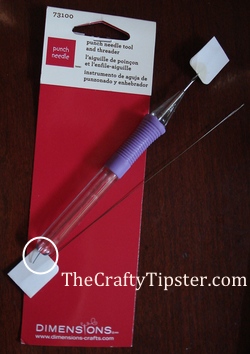 I purchased a Dimensions Needlecrafts Punch Needle, Tool and Threader
I purchased a Dimensions Needlecrafts Punch Needle, Tool and Threader from Amazon. It was one of the less expensive punch needles (at the time). It came with 2 needle threaders and I figured buying the same brand as my kit was probably a good idea.
Before I started, I headed off to YouTube. There was a wonderful Russian woman, who shared her techniques with a series of tutorials. She went through design choice and transfer all the way to finishing her work with a few smears of fabric glue. Others shared their hints and tips. Before I knew it, it was 3 am. But, I had learned so much and knew there would be some trial and error to punch needle embroidery. Pretty much like anything you do for the first time.
I was prepared for the first stitches to unravel. I was prepared to cut or otherwise fray my thread with the needle (only happened once, yay). And, I knew the precut DMC floss strands would mean a whole lot of time wasted threading my needle.
What I wasn’t prepared for was instructions that did not work with my tool and needle threaders that are way too short.
Dimensions’ Short Needle Threaders
Let’s start with the needle threaders. The needle punch has a central tube. You have to pull the thread through the tube and thread it through the needle’s eye. Most of the videos showed nice long threaders that were several inches longer than their needle punches. The two needle threaders supplied by Dimensions are just under 1/2 inch longer than the punch (circled area of picture). At 5 3/4 inches long, they’re workable, but just barely. I might try making my own threader with super thin beading wire (34 gauge) or hunt on Etsy for some pre-made ones.
Too Much Thread
The instructions on the packaging for the needle itself show you how to thread the needle but that’s it. The back of the box my kit came in shows someone using the needle I purchased. However, my kit said to use 3 strands of floss at a time. Thank goodness I had watched those videos. If the thread does not travel easily through the punch needle, it won’t work and the stitches will not stay in place.
Three strands of thread fit in the punch needle very snugly and none of the stitches would stay in the fabric. I realized the thread was not smoothly sliding through the punch. I removed one of the strands of floss and that seemed to fix it. So, to anyone else buying the Dimensions Needlecrafts Punch Needle – use 2 strands of embroidery thread instead of 3, like their kits recommend.
The irony about too much thread is the folks at Dimensions were quite generous with the thread that came with the kit. When I opened it, I thought it seemed like a crazy amount of thread for such a small design. I wondered if punch needle embroidery took far longer than the videos made it seem.
My Observations & Tips for Needle Punching (thoughts from a first-time puncher)
- After spending several hours working on my project, I still don’t understand why the loops stay in place – there’s no knots or backstitching to hold things in place. A gentle tug on the thread and the stitches practically jump out of the fabric – great for undoing mistakes, not so good for your nerves. lol. If you are not framing your embroidery, perhaps a thin smear of fabric glue to hold everything in place would be a good idea.
- If you are not careful and push the needle into the same hole as the last stitch, you will end up with a long, unsightly loop in the middle of your work. The experts said these could be trimmed without worry. They are right. But, after I put my project up for the day, I thought, “Duh, just pull them out and redo them.” sigh
- The Dimensions Punch Needle fit in my hand fairly well. The little rubber grip on the handle made it easy to hold.
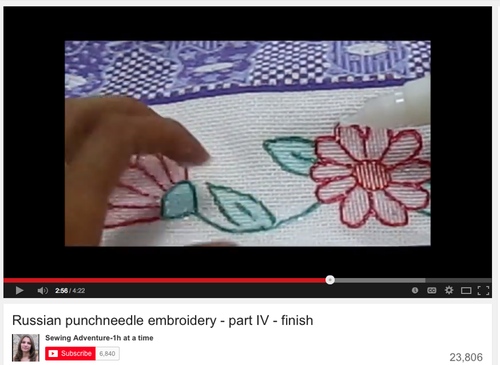 Don’t expect the back of your work to look like the folks in the videos. One of the women mentioned having made punch needle rugs for over 20 years. The Russian artist I watched was working on a dish towel with a cross stitch insert.Her stitches were so neat and tidy that they practically disappeared into the fabric. Check out the picture to the right. Both sides of her piece were presentation ready. I was able to get a rhythm going and do have sections of my work that look like hers. But, most of it is a mess of extra loops and puffs.
Don’t expect the back of your work to look like the folks in the videos. One of the women mentioned having made punch needle rugs for over 20 years. The Russian artist I watched was working on a dish towel with a cross stitch insert.Her stitches were so neat and tidy that they practically disappeared into the fabric. Check out the picture to the right. Both sides of her piece were presentation ready. I was able to get a rhythm going and do have sections of my work that look like hers. But, most of it is a mess of extra loops and puffs.- Shame on Dimensions for being so stingy with their needle threaders. For crying out loud, the amount of wire involved to make it another inch or two long couldn’t even cost you a penny.
- Thank goodness I checked out the videos first. I knew right away the thread was too thick (another demerit for Dimensions on that one). Thanks to the expert Youtuber who mentioned poking the needle in the eye, I learned which way to run the yarn through the eye of the needle.
- One video mentioned saving time by working side to side. That turned into a lesson on learning to walk before you can run. I tried her technique out immediately. That portion of my embroidery is almost as thick on the back as it is on the front.When I took the time to work ‘forward’ and turn the needle and the piece, I tended to achieve sections of those beautiful tiny stitches I saw on the video tutorials. Whereas, needle punching is fairly simple to do, mastering it will take practice.
- I had been worried about the look of the work of some of the experts. They stitched in rows. Those rows created a visible texture to their embroideries. It worked for some things but looked weird to me on some others. Perhaps over-filling (I worry there are gaps between the stitches and don’t always stick to my rows) or using only two strands of thread creates no discernible pattern to the loops. Yay.
Punch Needle Tool Kits
Since I originally wrote this post about punch needle embroidery, the marketplace, at least on Amazon, has changed. A number of the punch needles and needle threaders that I found in 2015 are simply no longer available. However, there has been a veritable deluge of Chinese products; many of which coincidentally look a lot like what I saw in 2015 under more familiar brand names. They offer an array of pieces for not all that much more than the punch needles alone used to cost. Some come with tapestry needles, embroidery hoops, embroidery floss and all sorts of other little extras. My advice? Read the reviews, carefully.
When shopping for punch needles and accessories, my tip, is to always read the reviews skeptically. Clearly, some folks do not understand what they are buying. They complain about a lack of instructions when none were promised in the first place. They think these tools are some magical way to speed up hand embroidery stitches or cross stitch. What they are is a specialized tool to create a specific type of embroidery – needle punch.
I have not ordered any of these kits but they do look good for the price. I have seen quite a few negative reviews. However, I suspect a lot of them are by folks who thought punch needling was not a skill that required learning. Punch needle embroidery is far from rocket science, but, it I suspect folks thought it was somehow effortless.
For your convenience, I’ve went through the many products being offered for you. These seem like the best of the group based on reviews and what they include in the offer.
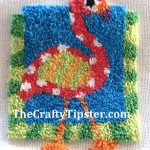
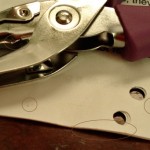

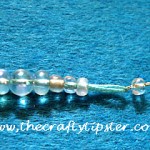
$1 pure bargs thats, I have to pay £3 in my local hobby craft in england which is probably like $5. What brand glue do you use?
Yes, I have a local 100 pennies chain (I think they have 3 or 4 stores total) that seems to really have the inside track when it comes to getting arts and crafts supplies. They have half an aisle of just scrapbooking stuff that on average sells for $3-6. Some of it is from last year’s lines but I doubt that matters for most folks.
Glue brand? Sadly my favorite is some Sargeant Arts tacky glue that I picked up at a discount store. Love the stuff but they’ve discontinued it. One of the big pitfalls of bargain shopping – you can’t always get more of the great stuff.
I didn’t end up using any glue on my punch needle work. I figure if it was framed or displayed that it wouldn’t get jiggled that much. If I was making something to wear, I would probably research some washable fabric glue or some sort of iron on patch to help hold everything in place.
I thread my needle I followed the direction and when I start punching my thread comes out it will not stay in the fabric why? What am I doing wrong
I’m not entirely sure Kathy. But, I do know if you don’t make the stitches very close together they’ll come out. Maybe that’s the problem?
Needle punching has always seemed difficult to me. After reading this, I think I may just need to give it a shot and see what happens.
I would love to get started in embroidery and create my own designs. Getting a needle and threader could really be a convenient solution to threading the needle. Considering the amount of thread that you use in the project, I had no idea can really make a difference in the aesthetics of your piece.
Thank you so much. I was trying to find a blog about this as the YouTube videos I watched were not covering the too much thread issue…and o could not get it to work. Took put some strands and voila! 😃
Hi Sarah,
Yes, I had quite a time figuring out how to get the smooth action that all the videos showed. So frustrating, it would be one thing if I wasn’t using a Dimensions kit with a Dimensions needle but how silly of them to tell you to use too much thread.
So glad my post helped you out.
Happy stitching!
Hi Michele, thanks so much for your info, after at least 10 hrs of total confusion and my thread not catching on the material I read your post and I finally figured it out. Like you said it doesn’t look exactly like the picture, lol, but it’s a start. I have a dimension piece as well.
Again thanks for your post I was determined to figure this out, and thanks to you I did.
Oh Francis, your comment made my day!
Comments like yours make it so rewarding to create a site like The Crafty Tipster. I’m so glad I was able to help you figure it out.
For such an “easy” craft, I too found it frustrating to get started with punch needle embroidery. It’s not really that difficult, but, it does have its quirks and tricks.
Once I got the hang of it, I came to enjoy the process.
Thank you for visiting my site and taking the time to leave a comment that you found it helpful.
Happy Stitching!
Thank you. I thought it was just me not being able to get my Dimensions needle to work. Your tips finally got me going. You’re right. This is fun to do; once you get the hang of it.